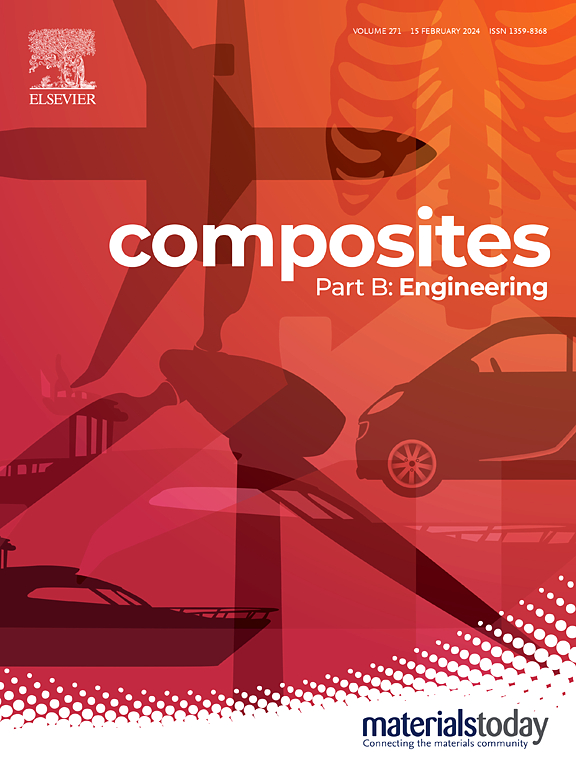Numerical study addressing the CER effect on microscopic chip removal mechanisms of CFRPs via the orthogonal cutting
IF 12.7
1区 材料科学
Q1 ENGINEERING, MULTIDISCIPLINARY
引用次数: 0
Abstract
Understanding the microscopic mechanisms of fiber fracture and removal plays a vital role in optimizing the cutting process and tool wear progression of carbon fiber reinforced polymers (CFRPs). Cutting edge radius (CER) is a critical parameter determining the surface formation of CFRPs as chip removal takes place by the action of cutting edge. In this study, micro-mechanical finite element (FE) models based on the maximum stress criteria were developed to reveal the influences of CER on fiber removal mechanisms governing the orthogonal cutting of UD-CFRPs. The results show that the CER significantly impacts both the transition of fiber removal modes and subsurface damage formation in CFRP cutting. At the 0° fiber orientation, increasing the CER tends to intensify the compression-induced fracture for fiber layers interacting with the tool. While for 45° and 90° fiber orientations, the key fiber separation mode changes from shear-induced fracture to bending-induced fracture as the CER rises. For the 135° fiber orientation, chip removal faces the greatest difficulty, with significant compressing and squeezing effects occurring, leading to poor fiber breakage and severe subsurface damage. Moreover, a smaller CER benefits the reduction of subsurface damage but increases the risk of edge chipping due to higher stresses concentrating at the cutting edge.
正交切削对cfrp微观切屑去除机理影响的数值研究
了解纤维断裂和去除的微观机制对于优化碳纤维增强聚合物(CFRPs)的切削工艺和刀具磨损进程具有重要意义。切削刃半径(CER)是决定cfrp在切削刃作用下表面形成的关键参数。本研究建立了基于最大应力准则的微力学有限元模型,揭示了CER对ud - cfrp正交切削纤维去除机制的影响。结果表明,剪切强度对CFRP切割过程中纤维去除模式的转变和亚表面损伤的形成均有显著影响。在纤维取向为0°的情况下,增大CER会加剧纤维层与工具相互作用导致的压缩断裂。而在45°和90°纤维取向下,随着CER的增大,关键纤维分离模式由剪切断裂转变为弯曲断裂。在135°纤维取向下,切屑去除难度最大,存在明显的压缩和挤压效应,导致纤维断裂程度较差,次表面损伤严重。此外,较小的CER有利于减少地下损伤,但由于在切削刃处集中了较高的应力,因此增加了边缘切屑的风险。
本文章由计算机程序翻译,如有差异,请以英文原文为准。
求助全文
约1分钟内获得全文
求助全文
来源期刊

Composites Part B: Engineering
工程技术-材料科学:复合
CiteScore
24.40
自引率
11.50%
发文量
784
审稿时长
21 days
期刊介绍:
Composites Part B: Engineering is a journal that publishes impactful research of high quality on composite materials. This research is supported by fundamental mechanics and materials science and engineering approaches. The targeted research can cover a wide range of length scales, ranging from nano to micro and meso, and even to the full product and structure level. The journal specifically focuses on engineering applications that involve high performance composites. These applications can range from low volume and high cost to high volume and low cost composite development.
The main goal of the journal is to provide a platform for the prompt publication of original and high quality research. The emphasis is on design, development, modeling, validation, and manufacturing of engineering details and concepts. The journal welcomes both basic research papers and proposals for review articles. Authors are encouraged to address challenges across various application areas. These areas include, but are not limited to, aerospace, automotive, and other surface transportation. The journal also covers energy-related applications, with a focus on renewable energy. Other application areas include infrastructure, off-shore and maritime projects, health care technology, and recreational products.
 求助内容:
求助内容: 应助结果提醒方式:
应助结果提醒方式:


